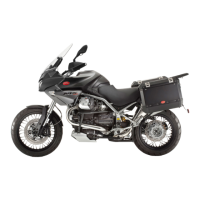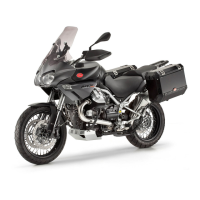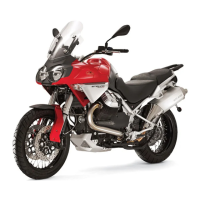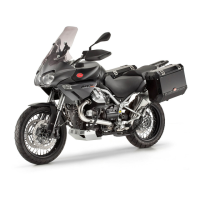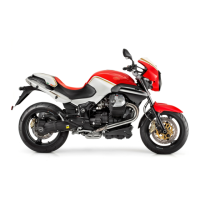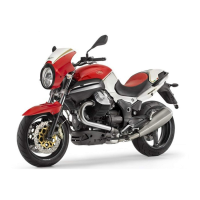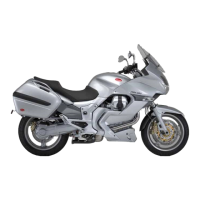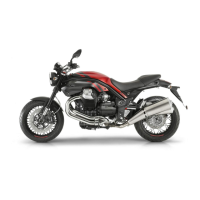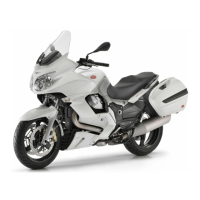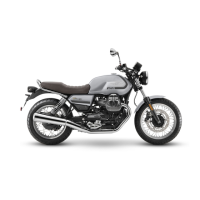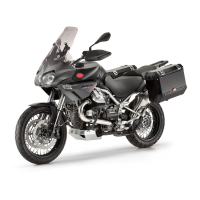
Do you have a question about the MOTO GUZZI Stelvio 1200 NTX 2011 and is the answer not in the manual?
| Displacement | 1151 cc |
|---|---|
| Bore x Stroke | 95 x 81.2 mm |
| Fuel System | Electronic fuel injection |
| Ignition | Electronic |
| Transmission | 6-speed |
| Final Drive | Shaft drive |
| Front Tire | 110/80 R19 |
| Rear Tire | 150/70 R17 |
| Seat Height | 840 mm |
| Engine Type | V-twin, 4-stroke |
| Maximum Power | 77 kW (105 hp) at 7, 250 rpm |
| Frame | Steel tubular frame |
| Front Suspension | 45 mm telescopic fork, adjustable |
| Rear Suspension | Single shock, adjustable |
| Front Brakes | Dual 320 mm discs |
| Rear Brakes | Single 282 mm disc |
Crucial safety information regarding hazardous substances and hot components.
General guidelines for vehicle maintenance, component handling, removal, and reassembly.
Guidelines for initial break-in and details on vehicle identification numbers.
Detailed data on engine, transmission, electrical, chassis, brakes, wheels, tyres, and fuel systems.
Tools required for engine, gearbox, and transmission maintenance.
Tools specific to steering, chassis, and front fork maintenance.
Comprehensive guide for routine maintenance tasks and intervals.
Procedures for checking and changing transmission, engine oil, and brake fluid.
Steps for air filter maintenance and valve clearance adjustment.
Procedures for bleeding the hydraulic braking system.
Guidance on routing, securing, and connecting electrical harnesses and components.
Information on accessing diagnostic menus and understanding ECU error codes.
Diagnosis and troubleshooting for various sensors and electrical components.
Explanation of ABS function, diagnosis, and fault handling.
Steps for preparing the vehicle and disconnecting engine components for removal.
Detailed steps for correctly installing the engine back into the vehicle.
Procedures for removing, disassembling, and reassembling the gearbox.
Instructions for clutch assembly, adjustment, and related checks.
Steps for cylinder head removal, valve inspection, and installation.
Procedures for inspecting and assembling crankshaft, connecting rods, and pistons.
Details on oil radiator, oil pump, and oil sump removal/installation.
Details on fuel pump, throttle body, and their components.
Procedure for synchronizing the engine cylinders using diagnostic tools.
Information on ECU screens, parameters, activation, and error management.
Procedures for removing/installing front wheel and handlebar.
Steps for disassembling, reassembling, and adjusting the front forks.
Details on removing, adjusting, and setting up the rear shock absorber.
Procedures for removing and checking the swinging arm and bevel gears.
Steps for removing and assembling gearbox casing and pinion unit.
Procedures for removing the exhaust system components.
Steps for removing and installing the engine oil cooler.
Explanation of ABS function, diagnosis, and fault finding.
Procedures for servicing brake callipers and checking brake discs.
Steps for replacing front and rear brake pads.
Procedures for bleeding the hydraulic braking system, including ABS bleeding.
Procedures for installing front lights and fairing components.
Steps for removing/installing the instrument panel and additional lights.
Procedures for removing rider footrest plates and side fairings.
Maintenance of the air box, air filter, and fuel tank removal.
Instructions for mounting panniers and adjusting the windscreen.
Inspections for finish, fasteners, and electrical systems.
Verification of fluid levels and performance tests.
Checks of major systems and installation of accessories like antitheft devices.
